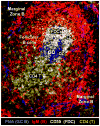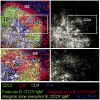Cytokine regulation of B-cell migratory behavior favors formation of germinal centers in autoimmune disease
- PMID: 21276413
- PMCID: PMC3249418
Cytokine regulation of B-cell migratory behavior favors formation of germinal centers in autoimmune disease
Abstract
Chemotaxis is essential for shaping immune responses and chemokine-receptor antagonists are now being evaluated as therapies for various inflammatory and autoimmune diseases. However, the dysregulation of chemotaxis in autoimmune disease may involve both promotion and inhibition of B-cell migration. This review focuses on the disparate mechanisms by which two inflammatory cytokines that have been associated with autoimmune disease, namely interferon-alpha (IFN-alpha) and interleukin-17 (IL-17), may regulate B-cell migratory responses. Chemotactic responses play a key role in orchestrating the cell-cell interactions in the germinal centers (GCs). This process involves active shuttling of the antigen-carrying B cells between the marginal zone and the GCs. We have shown that in autoimmune BXD2 mice, the migration of marginal zone precursor B cells is promoted by high levels of IFN-alpha produced by plasmacytoid dendritic cells in the marginal sinus that antagonize the activity of the S1P(1) chemokine receptor. In contrast, within the GCs, interleukin-17A (IL-17A) upregulates the expression of regulators of G protein signaling (RGS) in B cells to desensitize the G protein-coupled receptor (GPCR) signaling pathway of CXCL12 and CXCL13 chemokines. This promotes a prolonged stable interaction of B and T cells in the GC that induces high levels of activation-induced cytidine deaminase (AICDA) thereby enabling development of pathogenic autoantibody-producing B cells.
Conflict of interest statement
The authors report no conflicts of interest.
Figures



Similar articles
-
Marginal zone precursor B cells as cellular agents for type I IFN-promoted antigen transport in autoimmunity.J Immunol. 2010 Jan 1;184(1):442-51. doi: 10.4049/jimmunol.0900870. Epub 2009 Nov 30. J Immunol. 2010. PMID: 19949066 Free PMC article.
-
Inhibition of the catalytic function of activation-induced cytidine deaminase promotes apoptosis of germinal center B cells in BXD2 mice.Arthritis Rheum. 2011 Jul;63(7):2038-48. doi: 10.1002/art.30257. Arthritis Rheum. 2011. PMID: 21305519 Free PMC article.
-
Interleukin 17-producing T helper cells and interleukin 17 orchestrate autoreactive germinal center development in autoimmune BXD2 mice.Nat Immunol. 2008 Feb;9(2):166-75. doi: 10.1038/ni1552. Epub 2007 Dec 23. Nat Immunol. 2008. PMID: 18157131
-
IL-17 superfamily cytokines modulate normal germinal center B cell migration.J Leukoc Biol. 2016 Nov;100(5):913-918. doi: 10.1189/jlb.1VMR0216-096RR. Epub 2016 Aug 26. J Leukoc Biol. 2016. PMID: 27566830 Review.
-
Finding the right niche: B-cell migration in the early phases of T-dependent antibody responses.Int Immunol. 2010 Jun;22(6):413-9. doi: 10.1093/intimm/dxq047. Int Immunol. 2010. PMID: 20508253 Free PMC article. Review.
Cited by
-
Interferon-induced mechanosensing defects impede apoptotic cell clearance in lupus.J Clin Invest. 2015 Jul 1;125(7):2877-90. doi: 10.1172/JCI81059. Epub 2015 Jun 22. J Clin Invest. 2015. PMID: 26098211 Free PMC article.
-
Antiretroviral Therapy Normalizes Autoantibody Profile of HIV Patients by Decreasing CD33⁺CD11b⁺HLA-DR⁺ Cells: A Cross-Sectional Study.Medicine (Baltimore). 2016 Apr;95(15):e3285. doi: 10.1097/MD.0000000000003285. Medicine (Baltimore). 2016. PMID: 27082567 Free PMC article. Clinical Trial.
-
IL-23 Promotes a Coordinated B Cell Germinal Center Program for Class-Switch Recombination to IgG2b in BXD2 Mice.J Immunol. 2020 Jul 15;205(2):346-358. doi: 10.4049/jimmunol.2000280. Epub 2020 Jun 17. J Immunol. 2020. PMID: 32554431 Free PMC article.
-
Virus-driven Inflammation Is Associated With the Development of bNAbs in Spontaneous Controllers of HIV.Clin Infect Dis. 2017 Apr 15;64(8):1098-1104. doi: 10.1093/cid/cix057. Clin Infect Dis. 2017. PMID: 28158448 Free PMC article.
-
Spontaneous germinal centers and autoimmunity.Autoimmunity. 2017 Feb;50(1):4-18. doi: 10.1080/08916934.2017.1280671. Autoimmunity. 2017. PMID: 28166685 Free PMC article. Review.
References
-
- Chang SH, Park H, Dong C. Act1 adaptor protein is an immediate and essential signaling component of interleukin-17 receptor. J Biol Chem. 2006;281(47):35603–35607. - PubMed
Publication types
MeSH terms
Substances
Grants and funding
LinkOut - more resources
Full Text Sources
Medical
Miscellaneous

